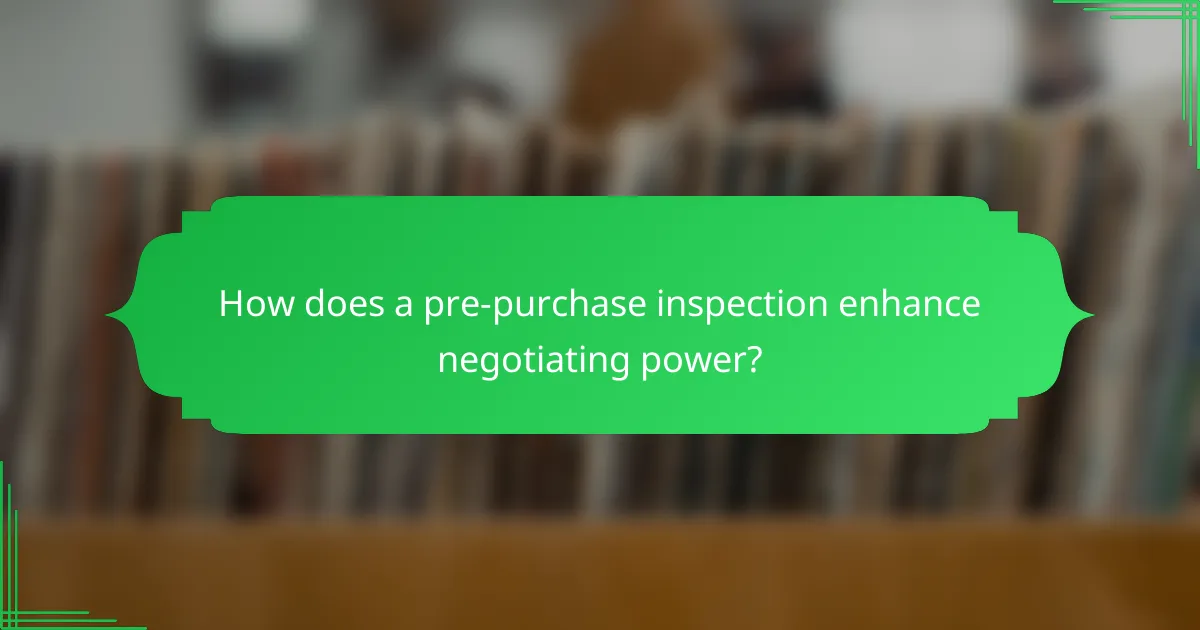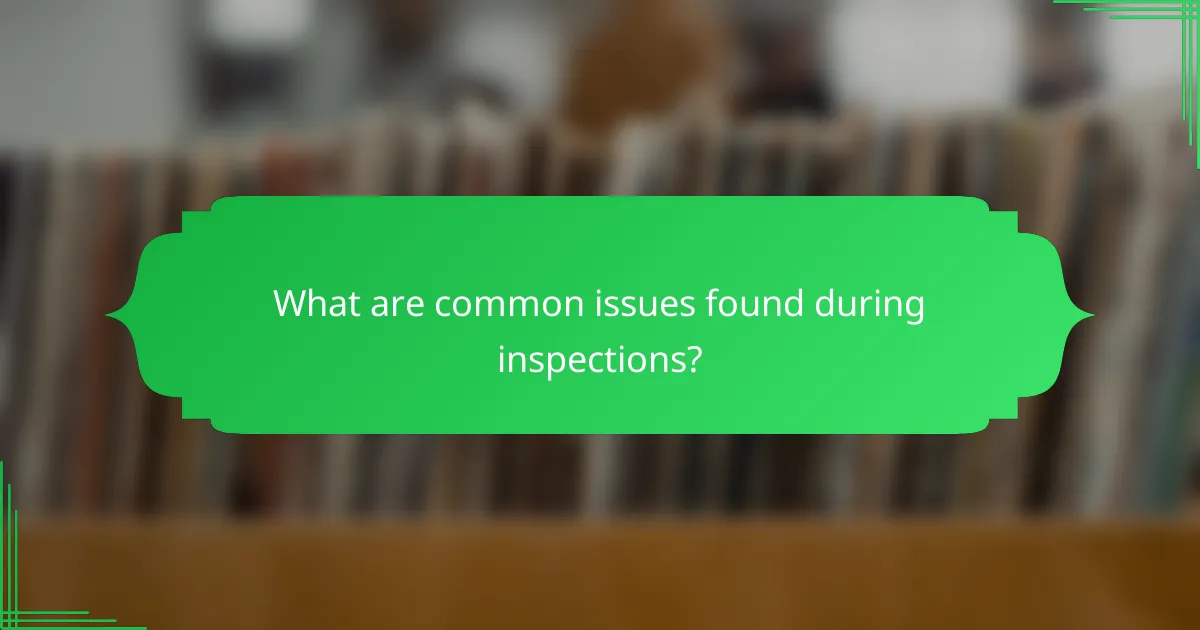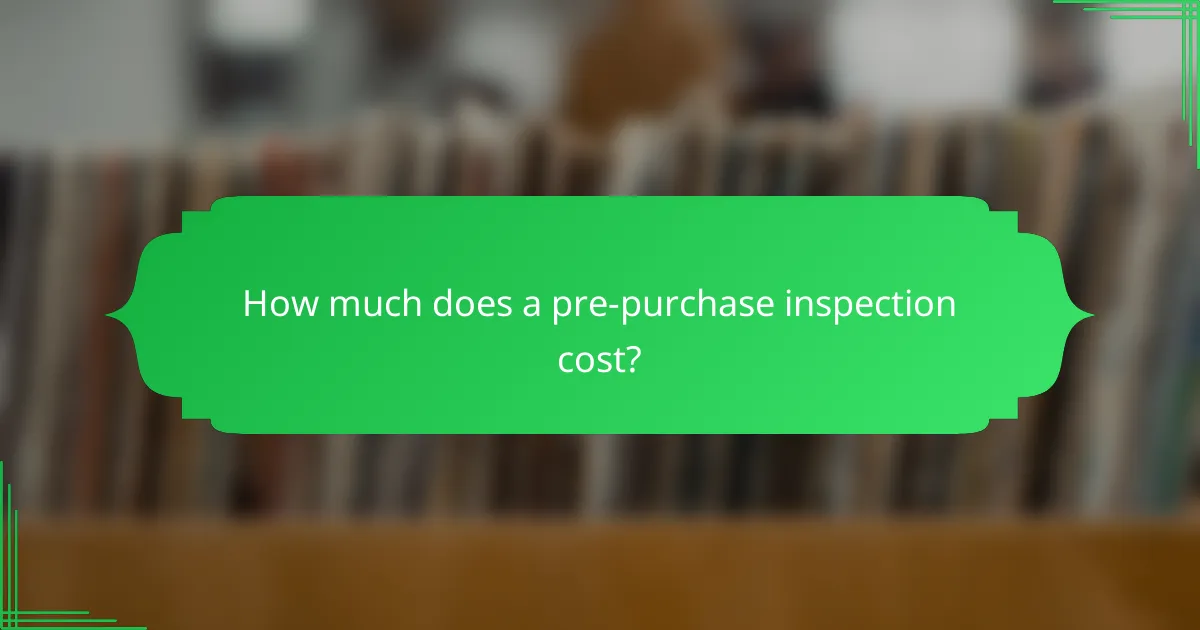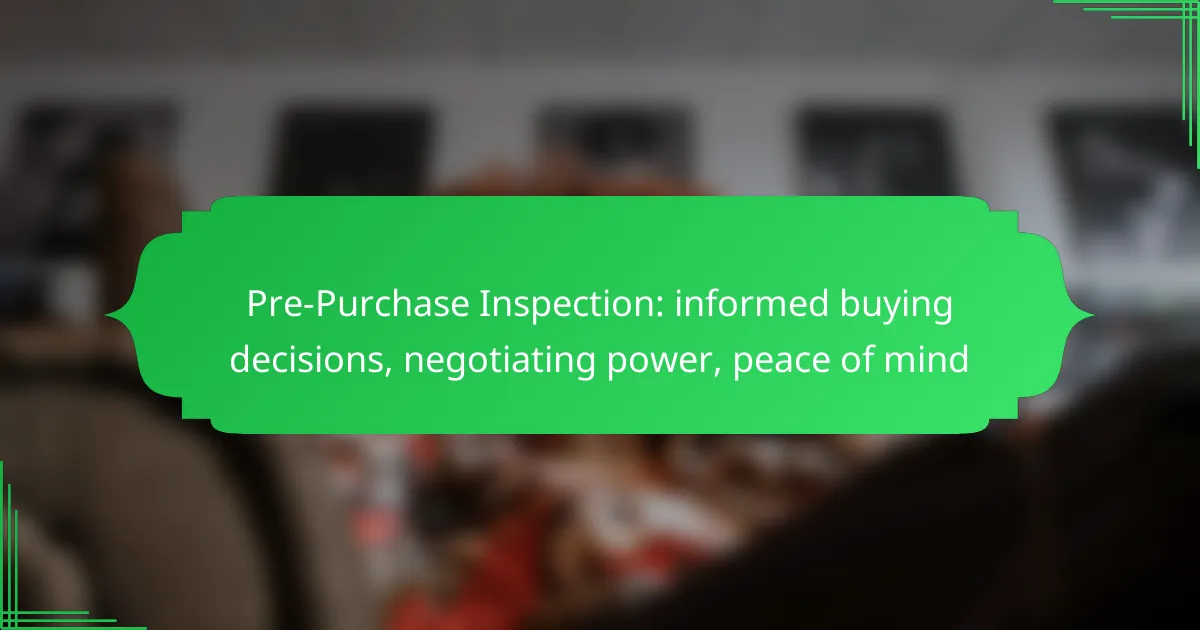A pre-purchase inspection is a crucial step for buyers looking to make informed decisions and enhance their negotiating power. By uncovering the true condition of a property or vehicle, this inspection allows buyers to address potential issues before finalizing a purchase, ultimately providing peace of mind and helping to avoid unexpected costs.

How does a pre-purchase inspection enhance negotiating power?
A pre-purchase inspection enhances negotiating power by revealing the true condition of a property or vehicle, allowing buyers to make informed decisions. This knowledge equips buyers with the ability to negotiate better terms and prices based on identified issues.
Identifies potential issues
A pre-purchase inspection systematically uncovers hidden problems that may not be visible during a casual viewing. Common issues include structural defects, mechanical failures, or safety concerns that could lead to costly repairs later. Identifying these potential issues early can save buyers from unexpected expenses and stress.
For instance, a home inspection might reveal outdated electrical systems or plumbing leaks, while a vehicle inspection could highlight engine problems or worn brakes. Knowing these details allows buyers to approach negotiations with a clear understanding of what needs to be addressed.
Provides leverage in negotiations
With the findings from a pre-purchase inspection, buyers gain significant leverage in negotiations. If issues are discovered, buyers can request repairs, ask for price reductions, or negotiate for additional concessions, such as covering closing costs or including warranties.
For example, if a home inspection reveals a need for a new roof, the buyer can negotiate a lower price that reflects the cost of the necessary repairs. This leverage can lead to more favorable terms and ultimately a better deal.
Establishes fair pricing
A pre-purchase inspection helps establish fair pricing by providing a benchmark for the property’s or vehicle’s condition. Buyers can compare the inspection results against similar items on the market to determine if the asking price is justified.
For instance, if comparable homes in the area are selling for a certain price but one has significant issues, the buyer can argue for a lower price based on the inspection findings. This ensures that buyers are not overpaying for a property or vehicle that requires significant investment to bring it up to standard.

What are the benefits of a pre-purchase inspection in the United States?
A pre-purchase inspection provides significant advantages for buyers in the United States, including informed decision-making, enhanced negotiating power, and peace of mind. By identifying potential issues before finalizing a purchase, buyers can make better choices and avoid unexpected costs.
Informed buying decisions
A pre-purchase inspection equips buyers with essential information about the condition of a vehicle or property. This knowledge enables them to assess whether the item meets their needs and expectations. For instance, discovering hidden defects can influence a buyer’s decision to proceed with the purchase or seek alternatives.
Buyers should consider hiring a qualified inspector who adheres to industry standards. This ensures that the inspection is thorough and reliable, providing a clearer picture of the asset’s condition.
Peace of mind for buyers
Having a pre-purchase inspection conducted offers buyers peace of mind, knowing they are making a sound investment. Understanding the condition of the item reduces anxiety about potential future problems. Buyers can feel confident that they are not overlooking critical issues that could lead to costly repairs.
Additionally, a detailed inspection report can serve as a valuable reference point during the buying process, allowing buyers to discuss findings with sellers and make informed choices.
Reduces future repair costs
Identifying issues early through a pre-purchase inspection can significantly reduce future repair costs. By addressing problems before completing the purchase, buyers can negotiate repairs or price adjustments with the seller. This proactive approach can save thousands of dollars in unexpected expenses down the line.
For example, if an inspection reveals a failing HVAC system, buyers can request repairs or a price reduction, potentially avoiding a significant financial burden after the purchase. Investing in an inspection is often far less expensive than dealing with major repairs later.

What should be included in a pre-purchase inspection report?
A pre-purchase inspection report should detail the condition of a property, highlighting any issues that may affect its value or safety. Key components typically include assessments of structural integrity, mechanical systems, and identification of safety hazards.
Structural integrity assessment
The structural integrity assessment evaluates the foundation, walls, roof, and other critical components to ensure they are sound and free from significant defects. Inspectors look for cracks, signs of settling, or water damage that could indicate underlying problems.
Common issues to be aware of include bowing walls, uneven floors, or moisture intrusion. Addressing these concerns early can save buyers from costly repairs later on.
Mechanical systems evaluation
This evaluation focuses on the property’s essential mechanical systems, including heating, cooling, plumbing, and electrical systems. Inspectors check for proper functionality, safety compliance, and any signs of wear or potential failure.
For example, a furnace that is over 15 years old may need replacement soon, while outdated electrical systems could pose safety risks. Understanding the condition of these systems helps buyers anticipate future expenses.
Safety hazard identification
Safety hazard identification involves checking for potential risks that could affect the occupants’ health and safety. This includes assessing for mold, asbestos, lead paint, and faulty wiring.
Buyers should be particularly cautious of any identified hazards, as remediation can be expensive and time-consuming. A thorough inspection can provide peace of mind and empower buyers to negotiate repairs or price adjustments based on findings.

How to choose a qualified inspector?
Choosing a qualified inspector is crucial for ensuring a thorough pre-purchase inspection. Look for professionals with the right credentials, solid reviews, and a range of services to meet your specific needs.
Check certifications and licenses
Verify that the inspector holds relevant certifications and licenses, which can vary by region. In the U.S., for example, many states require inspectors to be licensed, while others may have certification programs from organizations like the American Society of Home Inspectors (ASHI).
Ensure that the inspector’s qualifications align with the type of property you are purchasing, whether it’s residential, commercial, or specialized structures. This alignment can significantly impact the quality of the inspection.
Read reviews and testimonials
Look for reviews and testimonials from previous clients to gauge the inspector’s reliability and thoroughness. Websites like Yelp, Google Reviews, or Angie’s List can provide insights into the experiences of others.
Pay attention to feedback regarding the inspector’s communication skills, thoroughness of the report, and overall professionalism. A well-reviewed inspector often reflects a strong track record of satisfied clients.
Compare inspection services
Not all inspection services are created equal. Compare what different inspectors offer, such as additional services like radon testing, mold inspections, or thermal imaging. These extras can provide a more comprehensive view of the property’s condition.
Consider the cost of inspections, which can vary widely based on the property’s size and location. Typical inspection fees range from a few hundred to over a thousand dollars, depending on the complexity of the inspection and the inspector’s experience.

What are common issues found during inspections?
Common issues found during pre-purchase inspections can significantly impact the value and safety of a property. Identifying these problems early allows buyers to make informed decisions and negotiate effectively.
Roofing problems
Roofing issues are among the most critical findings during inspections. Common problems include missing shingles, leaks, and signs of wear that could lead to water damage. Depending on the severity, repairs can range from a few hundred to several thousand dollars.
When inspecting a roof, look for sagging areas, discoloration, or granules in gutters, which indicate deterioration. Regular maintenance can extend a roof’s lifespan, but if major repairs are needed, consider negotiating the cost with the seller.
Electrical system deficiencies
Electrical system deficiencies can pose serious safety hazards. Common issues include outdated wiring, insufficient outlets, and non-functional circuit breakers. These problems can lead to fire risks and may require significant investment to rectify.
During an inspection, ensure that the electrical panel is up to code and that all outlets are grounded. If you find any deficiencies, it’s wise to consult a licensed electrician for an estimate before finalizing the purchase.
Pest infestations
Pest infestations are another frequent concern during property inspections. Common pests include termites, rodents, and ants, which can cause extensive damage if left untreated. The cost of pest control can vary widely, depending on the type and extent of the infestation.
Look for signs of pests, such as droppings, nests, or damage to wood structures. If pests are detected, consider hiring a pest control expert for a thorough assessment and treatment plan, which can be a point of negotiation with the seller.

How much does a pre-purchase inspection cost?
A pre-purchase inspection typically costs between $100 and $500, depending on the type of vehicle and the inspection’s thoroughness. This investment can lead to informed buying decisions and greater negotiating power.
Factors Influencing Cost
Additionally, geographic location plays a significant role. Inspections in urban areas may be more expensive than in rural regions due to higher demand and operating costs. It’s advisable to research local rates to get a better understanding of what to expect.
What to Expect During an Inspection
During a pre-purchase inspection, a qualified mechanic will evaluate the vehicle’s overall condition, including its engine, transmission, brakes, and bodywork. They will also check for any signs of wear or damage that could indicate future problems. This comprehensive assessment helps buyers make informed decisions.
Expect to receive a detailed report outlining any issues found, along with recommendations for repairs. This information can be invaluable when negotiating the purchase price or deciding whether to proceed with the sale.
Benefits of a Pre-Purchase Inspection
A pre-purchase inspection provides peace of mind by uncovering potential issues before finalizing a purchase. This can save buyers from unexpected repair costs down the line. Knowing the vehicle’s condition allows for better negotiation leverage, as buyers can request price reductions based on the findings.
Moreover, having a professional assessment can help buyers avoid vehicles with hidden problems, ensuring they invest in a reliable car. Overall, the benefits of a pre-purchase inspection far outweigh the initial costs, making it a wise choice for any vehicle buyer.
